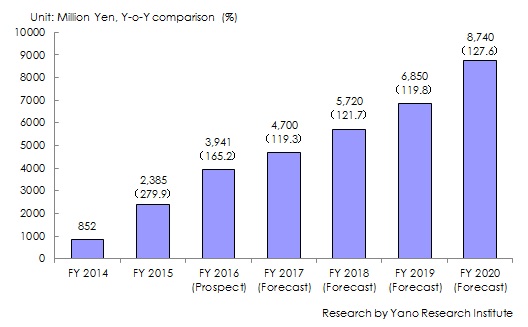Communication Robot Market in Japan: Key Research Findings 2017
Research Outline
- Research period: From January to March, 2017
- Research targets: Manufacturers of communication robots and those companies carrying out research and development of such robots, relevant public offices and organizations
- Research methodologies: Face-to-face interviews by the expert researchers, interviews via telephone/email, and literature research
What are Communication Robots?
The communication robots in this research indicate those robots that recognize the languages, faces, and existence of each of human being, and have such functions as detection of body touches by a human being and autonomous reaction according to the external information acquired, and those that are sufficient for practical use. This research calculated market size regarding those robots that possess functions resembling those certified as candidate products for practical use by the empirical research by AMED (Japan Agency for Medical Research and Development,) and those robots with a specific effects aiming to be put to practical use or those that have proved to have such effects.
Summary of Research Findings
- Size of FY2015 Domestic Communication Robot Market Leaped Forward to Attain 2,385 Million Yen, 279.9% on Y-o-Y Basis
With the products aiming to be put to practical use having started being on the market one after another since around 2015, the domestic communication robot market has grown tremendously to attain 2,385 million yen in FY2015, 279.9% of the size of the previous fiscal year, based on the shipment value at manufacturers.
- New Complex Type of Robots with Both Conversations and Actions Available Being Introduced in Succession to Lead Market
Ever since “Pepper” emerged in 2014, the complex type of communication robots able to communicate both with conversations and actions have attracted growing attention. In association with this, new products of such robots have begun being on the market one after another, which have led the market to be on the rise. In addition, AMED (Japan Agency for Medical Research and Development) has carried out a large-scale empirical research targeting long-term care facilities since FY2016, which is expected to clarify some challenges and problems in products for long term care for the makers of communication robots to recognize.
- FY2020 Domestic Communication Robot Market Projected to Achieve 8,740 Million Yen
By 2017 and beyond, the results of the research by AMED shall be unveiled to indicate the challenges and problems in using robots for long term care. Based on the results, the existing robots are expected to be improved and new products to be developed. Therefore, the needs of the robots for long-term care facilities are projected to continue expanding. In addition, there is a growing momentum for the complex type of communication robots able to communicate both with conversations and actions to be introduced at transportations and sightseeing areas toward the Tokyo Olympic Games in 2020, which can lead to additional demands for the robots. The domestic communication robot market for FY2020 is projected to be 8,740 million yen, based on the shipment value at manufacturers.
- Figure 1: Transition and Forecast of Domestic Communication Robot Market Size
